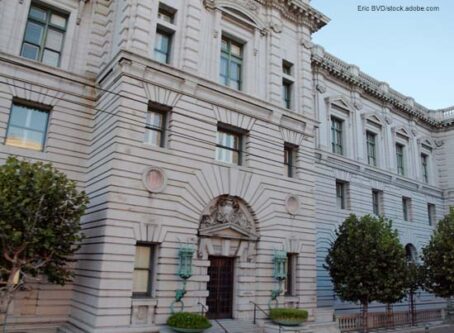Supreme Court says state property seizures can’t be ‘excessive’
The Supreme Court recently took a step in the direction of reining in civil asset forfeiture, a means state officials often use to seize money and other property suspected of being involved in a crime. It requires no conviction of a crime.
The Supreme Court did not make the act of civil asset forfeiture illegal. It did, however, rule that it can’t be excessive. It also is subject to review, and it can be challenged.
The Feb. 20 ruling was unanimous. It also was just a start. More lawsuits are expected to determine what “excessive” means and other issues.
In some instances, professional truck drivers have had assets seized through this process. For instance, if a driver is found by authorities to possess a substantial amount of cash, the authorities can presume the cash was from illegal means and seize it. The trucker then must prove the cash was “innocent” of any crime through a difficult process set up by the authorities that seized the money.
The Supreme Court’s recent ruling on civil asset forfeiture likely will come into play with a semi tractor-trailer seized by the Idaho State Police on Jan. 24.
The Idaho State Police has filed legal paperwork to take control of a truck used to transport more than 6,700 pounds of hemp from out of state through Idaho, according to a report from the Idaho State Journal. The agency apparently intends to sell the vehicle and use the money.
As reported in Land Line, Truck driver Dennis Palarmarchuk, 36, a trucker from Portland, Ore., was arrested during a routine inspection after officers found what they claimed was marijuana on the truck. He had a bill of lading identifying the cargo as hemp. Hemp is the fiber of the cannabis plant. It is used in rope, fabrics and paper. Marijuana is the flower buds and leaves of the plant. It contains significantly higher levels of THC.
The load is owned by Big Sky Scientific, Boise, Idaho. They have submitted test results to authorities showing the cargo was hemp. The semi is owned by third-party trucking company VIP Transporter, Portland, Ore.
Recent Supreme Court case
In the recent Supreme Court case, Timbs v. Indiana, a small-time drug dealer named Tyson Timbs had pleaded guilty to selling $225 worth of heroin to undercover police officers. He was sentenced to one year of house arrest and five years of probation. He also was ordered to pay $1,200 in fees and fines.
After the sentencing, Indiana authorities seized Timbs’ Land Rover. It had bought with money from an insurance policy payout he received when his father died. Indiana authorities claimed it had been used in heroin delivery.
An Indiana state court denied the forfeiture request, ruling that seizing the $42,000 vehicle was grossly disproportionate for a crime for which the maximum criminal fine would be $10,000. The Indiana Supreme Court overruled the lower court. It said the U.S. Constitution’s Excessive Fines Clause of the Eighth Amendment didn’t apply to state and local authorities.
The U.S. Supreme Court said, no, it did apply. The high court did not rule that the seizure was too much. It only said that a court could rule on it. Timbs has more legal hurdles to clear before getting his property returned to him.
It may be surprising that the Bill of Rights did not automatically apply to states. Before the 14th Amendment, the Bill of Rights only applied to federal jurisdiction. Since then, the Supreme Court has previously ruled over the years that most of the provisions of the Bill of Rights apply to states. The excessive fines clause was one of the few provisions not ruled to apply to states until this case.
Case does not stop civil asset forfeitures
Timbs was represented by Wesley Hottot, an attorney for the libertarian public interest law firm Institute for Justice. The institute names its four major issues as “private property, economic liberty, free speech and school choice.” At their website you can view a video of an interview with Timbs and read reports on civil asset forfeiture.
Civil asset forfeitures will not stop because of this ruling, Hottot said.
“People are still going to lose their property without being convicted of a crime, they’re still going to have their property seized,” Hottot told The New York Times. “The new thing is that they can now say at the end of it all, whether I’m guilty or not, I can argue that it was excessive.”
In an email to Land Line, Hottot said he had heard from individual truckers who have lost cash to civil forfeiture as they were traveling to look into buying a new tractor. While that case was not litigated, they were always looking for opportunities to litigate in this area.
James Mennella, an attorney with and principal in Oklahoma City, Okla., law firm McConnell & Mennella and columnist for Land Line Magazine, said his firm has not dealt with a lot of civil asset forfeitures but he remembered one for a few years ago.
It involved a driver who bob-tailed to visit a house that was being surveilled for prostitution. The driver was arrested, his truck was impounded, and the city brought a civil asset forfeiture case against the truck. Eventually, the driver got his truck back, Mennella said.
Five bullets
The Institute for Justice was in involved in a 2015 case in which a pickup truck was seized because the driver had left five bullets in the center console of his Ford F150.
Gerardo Serrano was driving a pickup truck from his home in Kentucky to visit relatives in Mexico. At the border in Texas, U.S. Customs and Border Patrol searched his truck and found the bullets. While he had a concealed carry permit, he did not have any weapon with him. He had forgotten about the bullets in the console. The Border Patrol declared that Serrano was transporting “munitions of war” and seized his truck.
Serrano has not been convicted or charged of a crime. The Institute for Justice took on the case in 2017. Serrano still does not have his truck.
Federal review of civil asset forfeiture
Several problems with civil asset forfeiture were outlined in a March 2017 report from the U.S. Department of Justice Office of Inspector General.
The OIG reviewed on the federal department’s oversight of cash seizure and forfeiture activities. It focused on the Drug Enforcement Administration because it was the source of 80 percent of the department’s cash seizures in fiscal years 2016 and 2017.
The department has collected more than $28 billion over the past 10 years through its asset forfeiture program, according to the OIG.
Regarding the DEA’s seizure and forfeiture activities, the OIG listed these reasons for concern:
- No judicial oversight.
- Property can be seized without the owner or possessor of the property being charged with a crime.
- The departments “largely proscribed” practice of adopting state seizures for federal forfeiture as a means to circumvent stat laws limiting forfeitures.
The OIG assessed 100 DEA cash seizures selected because of the potential for civil liberty concerns. These are some of the findings
- In 85 of 100 cases, seizures took place at transportation facilities, such as airports, parcel distribution centers, train stations and bus terminals, or were a result of a highway traffic stop.
- In all but six of the 85 cases just mentioned, there was no preexisting intelligence of a specific drug crime. In other words, it was the immediate, on-the-spot judgement of DEA agents.
- DEA could verify that only 44 of the 100 seizures (and only 29 of the 85 cases mentioned earlier) were related to ongoing investigations, resulted in new investigations, led to arrests, or led to prosecutions.
In addition, the OIG said the department’s seizure operations were inconsistent and that policy and training were inadequate. Further, state and local law enforcement officers were not trained on federal asset seizure and forfeiture laws.









